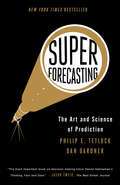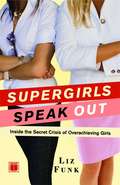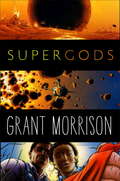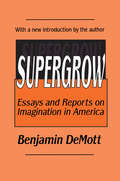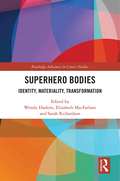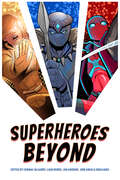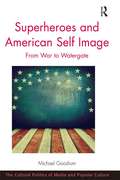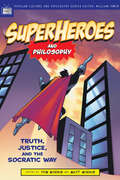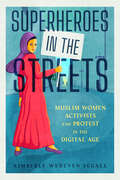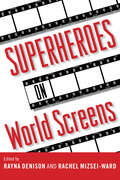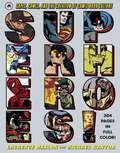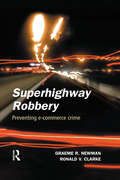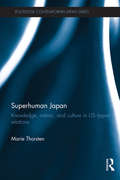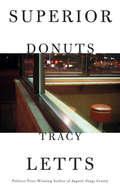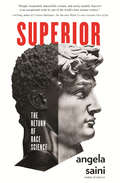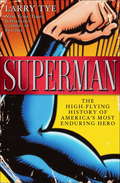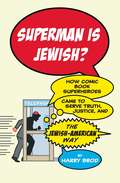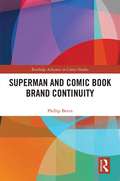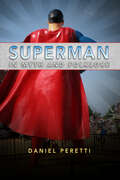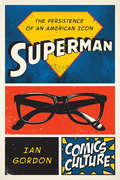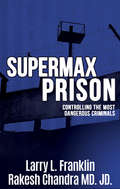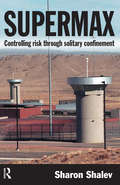- Table View
- List View
Superforecasting
by Philip E. Tetlock Dan GardnerA New York Times Bestseller"The most important book on decision making since Daniel Kahneman's Thinking, Fast and Slow."--Jason Zweig, The Wall Street Journal Everyone would benefit from seeing further into the future, whether buying stocks, crafting policy, launching a new product, or simply planning the week's meals. Unfortunately, people tend to be terrible forecasters. As Wharton professor Philip Tetlock showed in a landmark 2005 study, even experts' predictions are only slightly better than chance. However, an important and underreported conclusion of that study was that some experts do have real foresight, and Tetlock has spent the past decade trying to figure out why. What makes some people so good? And can this talent be taught? In Superforecasting, Tetlock and coauthor Dan Gardner offer a masterwork on prediction, drawing on decades of research and the results of a massive, government-funded forecasting tournament. The Good Judgment Project involves tens of thousands of ordinary people--including a Brooklyn filmmaker, a retired pipe installer, and a former ballroom dancer--who set out to forecast global events. Some of the volunteers have turned out to be astonishingly good. They've beaten other benchmarks, competitors, and prediction markets. They've even beaten the collective judgment of intelligence analysts with access to classified information. They are "superforecasters." In this groundbreaking and accessible book, Tetlock and Gardner show us how we can learn from this elite group. Weaving together stories of forecasting successes (the raid on Osama bin Laden's compound) and failures (the Bay of Pigs) and interviews with a range of high-level decision makers, from David Petraeus to Robert Rubin, they show that good forecasting doesn't require powerful computers or arcane methods. It involves gathering evidence from a variety of sources, thinking probabilistically, working in teams, keeping score, and being willing to admit error and change course. Superforecasting offers the first demonstrably effective way to improve our ability to predict the future--whether in business, finance, politics, international affairs, or daily life--and is destined to become a modern classic.
Superforecasting
by Philip E. Tetlock Dan GardnerA New York Times Bestseller"The most important book on decision making since Daniel Kahneman's Thinking, Fast and Slow."--Jason Zweig, The Wall Street Journal Everyone would benefit from seeing further into the future, whether buying stocks, crafting policy, launching a new product, or simply planning the week's meals. Unfortunately, people tend to be terrible forecasters. As Wharton professor Philip Tetlock showed in a landmark 2005 study, even experts' predictions are only slightly better than chance. However, an important and underreported conclusion of that study was that some experts do have real foresight, and Tetlock has spent the past decade trying to figure out why. What makes some people so good? And can this talent be taught? In Superforecasting, Tetlock and coauthor Dan Gardner offer a masterwork on prediction, drawing on decades of research and the results of a massive, government-funded forecasting tournament. The Good Judgment Project involves tens of thousands of ordinary people--including a Brooklyn filmmaker, a retired pipe installer, and a former ballroom dancer--who set out to forecast global events. Some of the volunteers have turned out to be astonishingly good. They've beaten other benchmarks, competitors, and prediction markets. They've even beaten the collective judgment of intelligence analysts with access to classified information. They are "superforecasters." In this groundbreaking and accessible book, Tetlock and Gardner show us how we can learn from this elite group. Weaving together stories of forecasting successes (the raid on Osama bin Laden's compound) and failures (the Bay of Pigs) and interviews with a range of high-level decision makers, from David Petraeus to Robert Rubin, they show that good forecasting doesn't require powerful computers or arcane methods. It involves gathering evidence from a variety of sources, thinking probabilistically, working in teams, keeping score, and being willing to admit error and change course. Superforecasting offers the first demonstrably effective way to improve our ability to predict the future--whether in business, finance, politics, international affairs, or daily life--and is destined to become a modern classic.
Superforecasting: The Art and Science of Prediction
by Philip E. Tetlock Dan GardnerA New York Times BestsellerAn Economist Best Book of 2015"The most important book on decision making since Daniel Kahneman's Thinking, Fast and Slow."--Jason Zweig, The Wall Street Journal Everyone would benefit from seeing further into the future, whether buying stocks, crafting policy, launching a new product, or simply planning the week's meals. Unfortunately, people tend to be terrible forecasters. As Wharton professor Philip Tetlock showed in a landmark 2005 study, even experts' predictions are only slightly better than chance. However, an important and underreported conclusion of that study was that some experts do have real foresight, and Tetlock has spent the past decade trying to figure out why. What makes some people so good? And can this talent be taught? In Superforecasting, Tetlock and coauthor Dan Gardner offer a masterwork on prediction, drawing on decades of research and the results of a massive, government-funded forecasting tournament. The Good Judgment Project involves tens of thousands of ordinary people--including a Brooklyn filmmaker, a retired pipe installer, and a former ballroom dancer--who set out to forecast global events. Some of the volunteers have turned out to be astonishingly good. They've beaten other benchmarks, competitors, and prediction markets. They've even beaten the collective judgment of intelligence analysts with access to classified information. They are "superforecasters." In this groundbreaking and accessible book, Tetlock and Gardner show us how we can learn from this elite group. Weaving together stories of forecasting successes (the raid on Osama bin Laden's compound) and failures (the Bay of Pigs) and interviews with a range of high-level decision makers, from David Petraeus to Robert Rubin, they show that good forecasting doesn't require powerful computers or arcane methods. It involves gathering evidence from a variety of sources, thinking probabilistically, working in teams, keeping score, and being willing to admit error and change course. Superforecasting offers the first demonstrably effective way to improve our ability to predict the future--whether in business, finance, politics, international affairs, or daily life--and is destined to become a modern classic.From the Hardcover edition.
Supergirls Speak Out
by Liz FunkSome girls seem to have it all... The top grades The best clothes A great body A cute boyfriend But they may also have... Exhaustion Anxiety Eating disorders Crippling insecurity From grammar school girls to working women, the pressure to be perfect is spreading like a disease. These Supergirls feel the unrelenting need to succeed -- sometimes at the cost of their own happiness and sanity. A recovering Supergirl herself, Liz Funk exposes the dangerous consequences that can come from striving for perfection. By closely following five girls and interviewing nearly one hundred more, she takes us inside the Supergirl psyche, explaining the causes of this phenomenon and showing how Supergirls can let their (sleek and shiny) hair down and find some time to relax and enjoy life! With practical advice, biting humor, and the sensitivity of someone who's been through it all, Funk's Supergirls Speak Out is the absolutely necessary companion for any girl who thinks 100 percent just isn't enough.
Supergods: Our World in the Age of the Superhero
by Grant MorrisonFrom one of the most acclaimed and profound writers in the world of comics comes a thrilling and provocative exploration of humankind's great modern myth: the superhero. The first superhero comic ever published, Action Comics no. 1 in 1938, introduced the world to something both unprecedented and timeless: Superman, a caped god for the modern age. In a matter of years, the skies of the imaginary world were filled with strange mutants, aliens, and vigilantes: Batman, Wonder Woman, the Fantastic Four, Iron Man, and the X-Men--the list of names as familiar as our own. In less than a century, they've gone from not existing at all to being everywhere we look: on our movie and television screens, in our videogames and dreams. But what are they trying to tell us? For Grant Morrison, arguably the greatest of contemporary chroniclers of the "superworld," these heroes are powerful archetypes whose ongoing, decades-spanning story arcs reflect and predict the course of human existence: Through them we tell the story of ourselves, our troubled history, and our starry aspirations. In this exhilarating work of a lifetime, Morrison draws on art, science, mythology, and his own astonishing journeys through this shadow universe to provide the first true history of the superhero--why they matter, why they will always be with us, and what they tell us about who we are . . . and what we may yet become.
Supergrow: Essays and Reports on Imagination in America
by Benjamin DeMottSupergrow is a collection of fifteen essays that appeared between 1966 and 1969 in publications such as the American Scholar, the New York Times, Antioch Review, Esquire, and the Saturday Review. Author Benjamin DeMott discusses everything under the sun--music, improving one's sex life, violence in Mississippi, theater, student revolts--but a single theme unifies the material: people ought to use their imaginations more. The book starts from the assumption that our troubles stem from failures of the imagination. Overcome by mass media, we are often too oblivious to fresh and original ideas. As DeMott states, "àthe right use of the constructive imagination increases the effectiveness of our energies, enables people to anticipate moves and countermoves, prevents them from becoming frozen into postures of intransigence or martyrdom which, though possessing a æterrible beauty,' have as their main consequence the stiffening of resistance and the slowing of change." Supergrow is a sociological and political critique of various aspects of everyday life in America, one informed by a powerful moral sensibility and an Emersonian sense of self-reliance. DeMott takes pop culture seriously, but exhibits a refreshing unwillingness to "go with the flow" and get caught up in fashionable intellectual fads. Graced with a new introduction by the author, Supergrow is an insightful work that is not afraid to tackle difficult subject matter. Whether discussing homosexuality, racism, popular music, or child rearing, Supergrow is well-reasoned, perceptive, and entertaining. As DeMott would hope, it will stimulate the imagination. "Devastating, sustained, profoundly witty, resounding." --New York Times Book Review "I didn't think it possible for a long time to come for any writer to say anything about black-and-white relations or lack of them that had freshness and pertinence. I was wrong."--Nat Hentoff, Village Voice Benjamin DeMott is an essayist, novelist, and journalist. He was professor of English at Amherst College, and a consultant and writer for National Educational Television. He is the author of The Body's Cage, Killer Blues: Why Americans Can't Think Straight about Gender and Power, and You Don't Say, available from Transaction.
Superhero Bodies: Identity, Materiality, Transformation (Routledge Advances in Comics Studies)
by Sarah Richardson Wendy Haslem Elizabeth MacFarlaneThroughout the history of the genre, the superhero has been characterised primarily by physical transformation and physical difference. Superhero Bodies: Identity, Materiality, Transformation explores the transformation of the superhero body across multiple media forms including comics, film, television, literature and the graphic novel. How does the body of the hero offer new ways to imagine identities? How does it represent or subvert cultural ideals? How are ideologies of race, gender and disability signified or destabilised in the physicality of the superhero? How are superhero bodies drawn, written and filmed across diverse forms of media and across histories? This volume collects essays that attend to the physicality of superheroes: the transformative bodies of superheroes, the superhero’s position in urban and natural spaces, the dialectic between the superhero’s physical and metaphysical self, and the superhero body’s relationship with violence. This will be the first collection of scholarly research specifically dedicated to investigating the diversity of superhero bodies, their emergence, their powers, their secrets, their histories and their transformations.
Superheroes Beyond
by Cormac McGarry, Liam Burke, Ian Gordon, and Angela NdalianisContributions by Mitchell Adams, Frederick Luis Aldama, Jason Bainbridge, Djoymi Baker, Liam Burke, Octavia Cade, Hernan David Espinosa-Medina, Dan Golding, Ian Gordon, Sheena C. Howard, Aaron Humphrey, Naja Later, Cormac McGarry, Angela Ndalianis, Julian Novitz, Alexandra Ostrowski Schilling, Maria Lorena M. Santos, Jack Teiwes, and Enrique Uribe-Jongbloed In recent years, superheroes on the page and screen have garnered increasing research and wider interest. Nonetheless, many works fall back on familiar examples before arriving at predictable conclusions. Superheroes Beyond moves superhero research beyond expected models. In this innovative collection, contributors unmask international crimefighters, track superheroes outside of the comic book page, and explore heroes whose secret identities are not cisgender men. Superheroes Beyond responds to the growing interest in understanding the unique appeal of superheroes by reveling in the diversity of this heroic type. Superheroes Beyond explores the complexity and cultural reach of the superhero in three sections. The first, “Beyond Men of Steel,” examines how the archetype has moved beyond simply recapitulating the “man of steel” figure to include broader representations of race, gender, sexuality, and ableness. The second section, “Beyond Comic Books,” discusses how the superhero has become a transmedia phenomenon, moving from comic books to toys to cinema screens and beyond. The final section, “Beyond the United States,” highlights the vibrant but often overlooked history of global superhero figures. Together, the essays in this collection form important starting points for taking stock of the superhero’s far-reaching appeal, contributing the critical conversations required to bring scholarship into the present moment and beyond.
Superheroes and American Self Image: From War to Watergate (The Cultural Politics of Media and Popular Culture)
by Michael GoodrumThis book offers an interdisciplinary approach to the study of comic-books, mobilising them as a means to understand better the political context in which they are produced. Structured around key political events in the US between 1938 and 1975, the author combines analyses of visual and textual discourse, including comic-book letters pages, to come to a more complete picture of the relationship between comic-books as documents and the people who read and created them. Exploring the ways in which ideas about the US and its place in the world were represented in major superhero comic-books during the tumultuous period of US history from the Great Depression to the political trauma of Watergate and the end of the Vietnam War, Superheroes and American Self-Image sheds fresh light on the manner in which comic-books shape and are shaped by contemporary politics. As such it will appeal to scholars of cultural and media studies, history and popular culture.
Superheroes and Philosophy
by William Irwin Tom Morris Matt MorrisThe comic book naratives of superheroes wrestle with profound and disturbing issues in original ways: the definitions of good and evil, the limits of violence as an effective means, the perils of enforcing justice outside the law, the metaphysics of personal identity, and the definition of humanity.Superheroes and Philosophy tackles these and other philosophical questions in an intellectual yet engaging way suitable for any comic book fan.
Superheroes in the Streets: Muslim Women Activists and Protest in the Digital Age (Race, Rhetoric, and Media Series)
by Kimberly Wedeven SegallThe icon of the female protester and her alter-ego, the female superhero, fills screens in the news, in theaters, and in digital spaces. The female protester who is Muslim, though, has been subject to a legacy of discrimination. Superheroes in the Streets: Muslim Women Activists and Protest in the Digital Age follows the stories of both famous and grassroots Muslim female protestors, bringing careful attention to protest modes and online national icons.US Muslim women have long navigated public and digital spaces aware of the complex and nuanced histories that trail them. Given the pervasive influence of mainstream feminism, Muslim women activists are often made out to be damsels in distress. Even when mass media turns its attention to the activism of Muslim women, persistence of these false narratives demeans their culture and hypersexualizes their bodies.Following the stories of US Muslim women activists, author Kimberly Wedeven Segall shows how they have been reinventing the streets and remaking racialized codifications. Segall highlights their creativity in crafting protest media of posters, rap rally songs, and digital images of superheroes, carving public spaces into inclusive and digital territories. Each chapter teases apart the complexities of public banners and digital activism.
Superheroes on World Screens
by Rayna Denison Rachel Mizsei-WardSuperheroes such as Superman and Spider-Man have spread all over the world. As this edited volume shows, many national cultures have created or reimagined the idea of the superhero, while the realm of superheroes now contains many icons whose histories borrow from local folklore and legends. Consequently, the superhero needs reconsideration, to be regarded as part of both local and global culture as well as examined for the rich meanings that such broad origins and re-workings create.This collection stands out as the first concentrated attempt to think through the meanings and significance of the superhero, not only as a product of culture in the United States, but as a series of local, transnational, and global exchanges in popular media. Through analysis of mainly film, television, and computer screens, contributors offer three challenges to the idea of the "American" superhero: transnational reimagining of superhero culture, emerging local superheroes, and the use of local superheroes to undermine dominant political ideologies. The essays explore the shifting transnational meanings of Doctor Who, Thor, and the Phantom, as these characters are reimagined in world culture. Other chapters chart the rise of local superheroes from India, the Middle East, Thailand, and South Korea. These explorations demonstrate how far superheroes have traveled to inspire audiences worldwide.
Superheroes!: Capes, Cowls, and the Creation of Comic Book Culture
by Laurence MaslonSuperman, Batman, Spider-Man, Iron Man, Wonder Woman, the Avengers, the X-Men, Watchmen, and more: the companion volume to the PBS documentary series of the same name that tells the story of the superhero in American popular culture. Together again for the first time, here come the greatest comic book superheroes ever assembled between two covers: down from the heavens--Superman and the Mighty Thor--or swinging over rooftops--the Batman and Spider-Man; star-spangled, like Captain America and Wonder Woman, or clad in darkness, like the Shadow and Spawn; facing down super-villains on their own, like the Flash and the Punisher or gathered together in a team of champions, like the Avengers and the X-Men! Based on the three-part PBS documentary series Superheroes, this companion volume chronicles the never-ending battle of the comic book industry, its greatest creators, and its greatest creations. Covering the effect of superheroes on American culture--in print, on film and television, and in digital media--and the effect of American culture on its superheroes, Superheroes: Capes, Cowls, and the Creation of Comic Book Culture appeals to readers of all ages, from the casual observer of the phenomenon to the most exacting fan of the genre. Drawing from more than 50 new interviews conducted expressly for Superheroes!--creators from Stan Lee to Grant Morrison, commentators from Michael Chabon to Jules Feiffer, actors from Adam West to Lynda Carter, and filmmakers such as Zach Snyder--this is an up-to-the-minute narrative history of the superhero, from the comic strip adventurers of the Great Depression, up to the blockbuster CGI movie superstars of the 21st Century. Featuring more than 500 full-color comic book panels, covers, sketches, photographs of both essential and rare artwork, Superheroes is the definitive story of this powerful presence in pop culture.From the Hardcover edition.
Superhighway Robbery (Crime Science Series)
by Ronald V. Clarke Graeme R. NewmanThis book, written by two leading authorities in the field, provides a systematic application of concepts of situational crime prevention to internet and e-commerce crime, exploring ways in which concepts of crime prevention developed in other contexts can be fruitfully applied in this new environment. Their argument is that situational crime prevention works, and is ideally suited to proving the means of developing measures to combat rapidly growing e-commerce crime. Chapters in the book seek to identify the specific opportunities and transactions in which crime can occur in the e-commerce environment, and the different kinds of information which are crime targets --identified as intellectual property, intelligence, information systems and services of various kinds (banking, purchasing etc). Consumer products are also examined with a view to identifying the elements that make them particularly vulnerable to theft.
Superhuman Japan: Knowledge, Nation and Culture in US-Japan Relations (Routledge Contemporary Japan Series)
by Marie ThorstenThis book examines the imaginative narratives that shaped the attitudes of Americans (and others) toward Japan. Focusing on cultural aspects of economic nationalism and US-Japan relations during the trade war Marie Thorsten uses examples from public discourse, film, documentaries, novels, acts of racism and comparison of international education assessments to examine the way in which Japan has been constituted in a global political gaze as an economic hegemon. In times of heightened rivalry, we often try to find superior "others" so that we can motivate ourselves against an imagined future of decline. During the Cold War, Americans and other nations in the West took advantage of being the underdog against the perceived superiority of the Soviet Union, especially by turning the Sputnik launch of 1957 into a lodestone for an educational renaissance. As postwar Japanese power became increasingly threatening, American policymakers again tried to fashion Japan into another "Sputnik" to motivate American people. This book explores 1980s "Bubble" Japan as a "Superhuman Other" in the consciousness of Americans, especially as reflected in popular culture and policy discourses. Making Japan into a Superhuman often resorted into the same stereotyping that invented Japan as a Subhuman. It was difficult for many to see that America, Japan and other nations were actually sharing the same global economic circumstances affecting attitudes toward knowledge and nation. This book will be of interest to students and scholars of Japanese politics, International Relations and Japanese culture and society.
Superior Donuts
by Tracy Letts"It is a meditation on Chicago's old soul . . . a witty, seductive, live-wire and greatly entertaining dark comedy that you just don't want to end." -Chicago Tribune"The sting, the speed and marksmanship of the gimcracks his characters fire at each other . . . drips the kind of soulful, energized sarcasm that has long characterized [Letts'] work as an actor and playwright."-Time Out Chicago Tracy Letts, who won the 2008 Pulitzer Prize for his epic, caustic Oklahoma family drama August: Osage County, has shifted gears with this entertaining comedy set in a donut shop. A love letter to the city where he has lived for more than twenty years, Letts describes his new work as "an exploration of the Chicago storefront experience." The play takes place in the north side neighborhood of Uptown, where Arthur Przybyszewski runs the donut shop that has been in his family for sixty years. More content to spend the day smoking weed and reminiscing about his Polish immigrant father, Arthur hires a shop assistant, the young African American Franco Wicks, who has both an unpublished novel and unpaid gambling debt. Superior Donuts premiered at Steppenwolf Theatre Company and recently opened on Broadway--following the same path of success as Letts' previous work.Tracy Letts is the author of Killer Joe, Bug, Man from Nebraska (nominated for the 2004 Pulitzer Prize), and August: Osage County (awarded the 2008 Pulitzer Prize for Drama). He is a member of Chicago's Steppenwolf Theatre Company.
Superior: The Return of Race Science
by Angela SainiAn astute and timely examination of the re-emergence of scientific research into racial differencesSuperior tells the disturbing story of the persistent thread of belief in biological racial differences in the world of science.After the horrors of the Nazi regime in WWII, the mainstream scientific world turned its back on eugenics and the study of racial difference. But a worldwide network of unrepentant eugenicists quietly founded journals and funded research, providing the kind of shoddy studies that were ultimately cited in Richard Hernstein's and Charles Murray's 1994 title, The Bell Curve, which purported to show differences in intelligence among races. If the vast majority of scientists and scholars disavowed these ideas, and considered race a social construct, it was still an idea that managed to somehow make its way into the research into the human genome that began in earnest in the mid-1990s and continues today. Dissecting the statements and work of contemporary scientists studying human biodiversity, most of whom claim to be just following the data, Saini shows us how, again and again, science is retrofitted to accommodate race. Even as our understanding of highly complex traits like intelligence, and the complicated effect of environmental influences on human beings, from the molecular level on up, grows, the hope of finding simple genetic differences between "races"--to explain differing rates of disease, to explain poverty or test scores or to justify cultural assumptions--stubbornly persists. At a time when racialized nationalisms are a resurgent threat throughout the world, Superior is a powerful reminder that biologically, we are all far more alike than different.
Superman
by Larry TyeSeventy-five years after he came to life, Superman remains one of America's most adored and enduring heroes. Now Larry Tye, the prize-winning journalist and New York Times bestselling author of Satchel, has written the first full-fledged history not just of the Man of Steel but of the creators, designers, owners, and performers who made him the icon he is today. Legions of fans from Boston to Buenos Aires can recite the story of the child born Kal-El, scion of the doomed planet Krypton, who was rocketed to Earth as an infant, raised by humble Kansas farmers, and rechristened Clark Kent. Known to law-abiders and evildoers alike as Superman, he was destined to become the invincible champion of all that is good and just--and a star in every medium from comic books and comic strips to radio, TV, and film. But behind the high-flying legend lies a true-to-life saga every bit as compelling, one that begins not in the far reaches of outer space but in the middle of America's heartland. During the depths of the Great Depression, Jerry Siegel was a shy, awkward teenager in Cleveland. Raised on adventure tales and robbed of his father at a young age, Jerry dreamed of a hero for a boy and a world that desperately needed one. Together with neighborhood chum and kindred spirit Joe Shuster, young Siegel conjured a human-sized god who was everything his creators yearned to be: handsome, stalwart, and brave, able to protect the innocent, punish the wicked, save the day, and win the girl. It was on Superman's muscle-bound back that the comic book and the very idea of the superhero took flight. Tye chronicles the adventures of the men and women who kept Siegel and Shuster's "Man of Tomorrow" aloft and vitally alive through seven decades and counting. Here are the savvy publishers and visionary writers and artists of comics' Golden Age who ushered the red-and-blue-clad titan through changing eras and evolving incarnations; and the actors--including George Reeves and Christopher Reeve--who brought the Man of Steel to life on screen, only to succumb themselves to all-too-human tragedy in the mortal world. Here too is the poignant and compelling history of Siegel and Shuster's lifelong struggle for the recognition and rewards rightly due to the architects of a genuine cultural phenomenon. From two-fisted crimebuster to über-patriot, social crusader to spiritual savior, Superman--perhaps like no other mythical character before or since--has evolved in a way that offers a Rorschach test of his times and our aspirations. In this deftly realized appreciation, Larry Tye reveals a portrait of America over seventy years through the lens of that otherworldly hero who continues to embody our best selves.
Superman Is Jewish?
by Harry BrodMany of us know that the superheroes at the heart of the American comic book industry were created by Jews. But we'd be surprised to learn how much these beloved characters were shaped by the cultural and religious traditions of their makers. Superman Is Jewish? follows the "people of the book" as they become the people of the comic book. Harry Brod reveals the links between Jews and superheroes in a penetrating investigation of iconic comic book figures. With great wit and compelling arguments, Brod situates superheroes within the course of Jewish- American history: they are aliens in a foreign land, like Superman; figures plagued by guilt for not having saved their families, like Spider-Man; outsiders persecuted for being different, like the X-Men; nice, smart people afraid that nobody will like them when they're angry, like the Hulk. Brod blends humor with sharp observation as he considers the overt and discreet Jewish characteristics of these well-known figures and explores how their creators--including Jerry Siegel, Joe Shuster, Stan Lee, and Jack Kirby-- integrated their Jewish identities and their creativity. Brod makes a strong case that these pioneering Jews created New World superheroes using models from Old World traditions. He demonstrates how contemporary characters were inspired by the golem, the mystically created artificial superhuman of Jewish lore. And before Superman was first drawn by Joe Shuster, there were those Jews flying through the air drawn by Marc Chagall. As poignant as it is fascinating, this lively guided tour travels from the Passover Haggadah's exciting action scenes of Moses's superpowers through the Yiddish humor of Mad to two Pulitzer Prizes awarded in one decade to Jewish comic book guys Art Spiegelman and Michael Chabon. Superman Is Jewish? explores the deeper story of how an immigrant group can use popular entertainment media to influence the larger culture and in the process see itself in new, more empowering ways. Not just for Jewish readers or comic book fans, Superman Is Jewish? is a story of America, and is as poignant as it is fascinating. *** A surprising question, one that takes a certain amount of chutzpah to even raise. To add even a bit more chutzpah, this book considers questions about the Jewishness of more superheroes than just Superman, and offers answers that will surprise many. You mean Spider-Man is Jewish too? Well, actually, yes, but in a very different way than Superman is. And, as we'll see, the shift between them reflects the evolution of Jewish life in America itself in the generation between the two, the generation that gets us from World War II and the "Golden Age" of comics to the 1960s and the "Silver Age" of comics. The historical turning points of those tumultuous years and others, like the powerful 1950s crusade against comics for supposedly causing juvenile delinquency, turn out to be central to our story because these events, and their great impact on American Jews, appear on comic book pages themselves, and behind the scenes in their production. For it turns out that the history of Jews and comic book superheroes, that very American invention, is the history of Jews and America, particularly the history of Jewish assimilation into the mainstream of American culture.
Superman and Comic Book Brand Continuity (Routledge Advances in Comics Studies)
by Phillip BevinSuperman and Comic Book Brand Continuity traces the development of comic book continuity through the case study of Superman, examining the character’s own evolution across several media, including comics, radio, television, and film. Superman’s relationship with continuity illustrates a key feature of the way in which people in western societies construct stories about themselves. In this respect, the book is a study of narrative and how comic book continuity reflects the way that, in wider western post-enlightenment culture, storytelling shapes the common sense and received wisdoms that influence how we perceive "reality." The scope of the analysis extends from Superman’s creation in the late 1930s to the recent films Man of Steel (2013) and Batman v. Superman: Dawn of Justice (2016), as well as the current comic book reboot Rebirth (2016).
Superman in Myth and Folklore
by Daniel PerettiSuperman rose from popular culture—comic books, newspaper strips, radio, television, novels, and movies—but people have so embraced the character that he has now become part of folklore. This transition from popular to folk culture signals the importance of Superman to fans and to a larger American populace. Superman’s story has become a myth dramatizing identity, morality, and politics. Many studies have examined the ways in which folklore has provided inspiration for other forms of culture, especially literature and cinema. In Superman in Myth and Folklore, Daniel Peretti explores the meaning of folklore inspired by popular culture, focusing not on the Man of Steel’s origins but on the culture he has helped create. Superman provides a way to approach fundamental questions of human nature, a means of exploring humanity’s relationship with divinity, an exemplar for debate about the type of hero society needs, and an articulation of the tension between the individual and the community. Through examinations of tattoos, humor, costuming, and festivals, Peretti portrays Superman as a corporate-owned intellectual property and a model for behavior, a means for expression and performance of individual identity, and the focal point for disparate members of fan communities. As fans apply Superman stories to their lives, they elevate him to a mythical status. Peretti focuses on the way these fans have internalized various aspects of the character. In doing so, he delves into the meaning of Superman and his place in American culture and demonstrates the character’s staying power.
Superman: The Persistence of an American Icon
by Ian GordonAfter debuting in 1938, Superman soon became an American icon. But why has he maintained his iconic status for nearly 80 years? And how can he still be an American icon when the country itself has undergone so much change?Superman: Persistence of an American Icon examines the many iterations of the character in comic books, comic strips, radio series, movie serials, feature films, television shows, animation, toys, and collectibles over the past eight decades. Demonstrating how Superman’s iconic popularity cannot be attributed to any single creator or text, comics expert Ian Gordon embarks on a deeper consideration of cultural mythmaking as a collective and dynamic process. He also outlines the often contentious relationships between the various parties who have contributed to the Superman mythos, including corporate executives, comics writers, artists, nostalgic commentators, and collectors. Armed with an encyclopedic knowledge of Superman’s appearances in comics and other media, Gordon also digs into comics archives to reveal the prominent role that fans have played in remembering, interpreting, and reimagining Superman’s iconography. Gordon considers how comics, film, and TV producers have taken advantage of fan engagement and nostalgia when selling Superman products. Investigating a character who is equally an icon of American culture, fan culture, and consumer culture, Superman thus offers a provocative analysis of mythmaking in the modern era.
Supermax Prison: Controlling the Most Dangerous Criminals
by Rakesh Chandra Larry FranklinThe penetrating look at the violence that swept prisons in the 1980’s and 1990’s and the organizational structure mirroring the Mafia that erupted in them. The inmates had to make a choice between joining a gang that offered protection, friendships, financial rewards, access to drugs and other contraband or serving as a lone inmate in a dangerous, even lethal world. The worst in this violent world were sent to a supermax prison. Tamms in Illinois was one of those supermax prisons.This is the story of Tamms."A must-read for anyone interested in the US criminal justice system and its supermax prisons." -- Elizabeth Theresa Klaver, Professor of English at Southern Illinois University"If you work at, administer with, or have anything to say about dangerous or mentally ill inmates, then this book is for you." -- Father Leo J. Hayes, M. Div., M.A., Author of “Evil In Mirror Lake”
Supermax: Controlling Risk Through Solitary Confinement
by Sharon ShalevThis book examines the rise and proliferation of 'Supermaxes', large prisons dedicated to holding prisoners in prolonged and strict solitary confinement, in the United States since the late 1980s. Drawing on unique access to two Supermax prisons and on in-depth interviews with prison officials, prison architects, current and former prisoners, mental health professionals, penal, legal, and human rights experts, it provides a holistic view of the theory, practice and consequences of these prisons. Given the historic uses of solitary confinement, the book also traces continuities and discontinuities in its use on both sides of the Atlantic over the last two centuries. It argues that rather than being an entirely 'new' form of imprisonment, Supermax prisons draw on principles of architecture, surveillance and control which were set out in the early 19th century but which are now enhanced by the most advanced technologies available to current day prison planners and administrators. It asks why a form of confinement which had been discredited in the past is now proposed as the best solution for dealing with 'difficult', 'dangerous' or 'disruptive' prisoners, and assesses the true costs of Supermax confinement.
Supernatural Entertainments: Victorian Spiritualism and the Rise of Modern Media Culture
by Simone NataleIn Supernatural Entertainments, Simone Natale vividly depicts spiritualism’s rise as a religious and cultural phenomenon and explores its strong connection to the growth of the media entertainment industry in the nineteenth century. He frames the spiritualist movement as part of a new commodity culture that changed how public entertainments were produced and consumed.Starting with the story of the Fox sisters, considered the first spiritualist mediums in history, Natale follows the trajectory of spiritualism in Great Britain and the United States from its foundation in 1848 to the beginning of the twentieth century. He demonstrates that spiritualist mediums and leaders adopted many of the promotional strategies and spectacular techniques that were being developed for the broader entertainment industry. Spiritualist mediums were indistinguishable from other professional performers, as they had managers and agents, advertised in the press, and used spectacularism to draw audiences.Addressing the overlap between spiritualism’s explosion and nineteenth-century show business, Natale provides an archaeology of how the supernatural became a powerful force in the media and popular culture of today.
